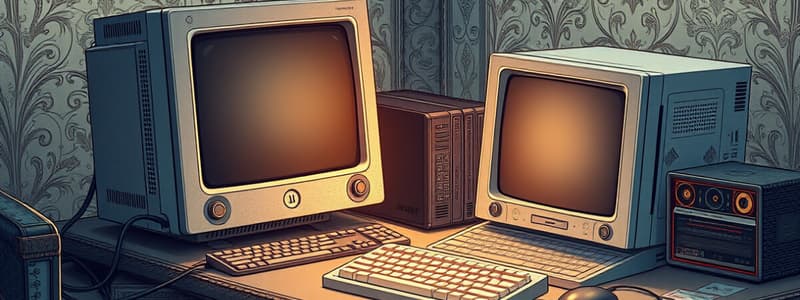Podcast
Questions and Answers
What is the primary function of the motherboard in a computer system?
What is the primary function of the motherboard in a computer system?
- To convert electrical power into usable form for the computer.
- To receive inputs from external devices.
- To connect and allow communication between all internal components. (correct)
- To handle the rendering of images and videos.
Which component is responsible for providing power to the computer's internal elements?
Which component is responsible for providing power to the computer's internal elements?
- Graphics Processing Unit
- Power Supply Unit (correct)
- Motherboard
- Input Devices
How does the Graphics Processing Unit (GPU) interact with the CPU?
How does the Graphics Processing Unit (GPU) interact with the CPU?
- It stores outputs permanently from the CPU.
- It provides data for the CPU to process.
- It connects input devices to the CPU.
- It receives data from the CPU for rendering. (correct)
What is the role of output devices in a computer system?
What is the role of output devices in a computer system?
During the booting process, which component initiates the power distribution to the motherboard?
During the booting process, which component initiates the power distribution to the motherboard?
What is a primary function of servers in a computer network?
What is a primary function of servers in a computer network?
Which type of personal computer is primarily designed for stationary use?
Which type of personal computer is primarily designed for stationary use?
What distinguishes workstations from regular personal computers?
What distinguishes workstations from regular personal computers?
Which of the following is NOT a type of server?
Which of the following is NOT a type of server?
Which describes embedded systems?
Which describes embedded systems?
Flashcards are hidden until you start studying
Study Notes
Computer Hardware
- Motherboard connects all components, providing electrical connections for communication.
- Power Supply Unit (PSU) converts electrical power and distributes it, ensuring correct voltage and current for components.
- Graphics Processing Unit (GPU) renders images and animations, alleviating CPU load during graphics-intensive tasks.
- Input devices (e.g., keyboard, mouse) allow user input, sending signals to the CPU for processing.
- Output devices (e.g., monitor, printer) display or produce processed data for user interaction.
- Booting process begins with PSU powering the motherboard, enabling the computer's startup sequence.
Personal Computers (PCs)
- General-purpose computers designed for individual use, capable of diverse tasks.
- Desktop Computers: Stationary systems used at one location; includes separate components like monitor and CPU.
- Laptops: Portable units that combine monitor, keyboard, and CPU, featuring built-in batteries for mobility.
- Tablets: Touchscreen devices for casual use; geared towards browsing and media consumption.
- Smartphones: Handheld devices merging mobile phone and computing functionalities.
Workstations
- High-performance computers tailored for technical and scientific tasks like graphic design and video editing.
Servers
- Provide services, resources, or data to clients over networks.
- File Servers: Manage file storage for network users.
- Web Servers: Host websites and handle incoming web traffic.
- Database Servers: Oversee databases and manage query processing.
- Application Servers: Host specific applications for network users.
Embedded Systems
- Specialized systems within larger devices performing dedicated functions in items like consumer electronics and medical devices.
Hybrid Computers
- Integrate features of both analog and digital computers, processing continuous and discrete data for specialized applications.
Computer Software
- Collection of programs, data, and instructions allowing computers to perform tasks; intangible yet essential for functionality.
- Divided into two main types: System Software and Application Software.
System Software
- Manages hardware and provides a platform for running applications.
- Operating Systems (OS): Critical system software managing other software and hardware; examples include Windows, MacOS, Linux.
- Device Drivers: Enable OS communication with hardware like printers.
- Utilities: Tools for system maintenance and optimization.
Operating Systems
- Manage hardware/software resources and offer common services for applications.
- Examples: Windows, MacOS, Linux, Android, iOS.
Functions of Operating Systems
- CPU Management schedules tasks and multitasks.
- Memory Management allocates/deallocates memory and manages virtual memory.
- I/O Management handles input/output devices like keyboards and monitors.
- File Management organizes files/directories and controls access permissions.
Types of Operating Systems
- Batch OS: Processes tasks in batches.
- Time-Sharing OS: Allows concurrent resource sharing among multiple users.
- Distributed OS: Manages a group of computers as a single entity.
- Real-Time OS: Used in systems requiring precise timing.
- Mobile OS: Designed for mobile devices (e.g., Android, iOS).
Operating System Components
- Kernel: Core component managing resources and device communication.
- Shell: User interface for interacting with the kernel, can be command-line or graphical.
Process Management
- Distinguishes between processes (program instances) and threads (smaller execution units).
- Discusses process states: new, ready, running, waiting, terminated.
- Covers scheduling types: long-term, short-term, medium-term with algorithms like FCFS, SJN, RR.
Memory Management
- Explains memory allocation and deallocation.
- Introduces virtual memory for larger applications.
- Describes paging and segmentation techniques for memory division.
File Systems
- Discusses file organization, storage access, and management.
- Explains file permissions (e.g., read, write, execute).
- Provides examples of common file systems: NTFS, FAT32, ext4, HFS+.
User Interface and Interaction
- Compares command-line interfaces (CLI) with graphical user interfaces (GUI).
- Discusses user modes, particularly user mode and kernel mode.
Security in Operating Systems
- Covers user authentication and authorization, emphasizing security risk management within OS.
Studying That Suits You
Use AI to generate personalized quizzes and flashcards to suit your learning preferences.




